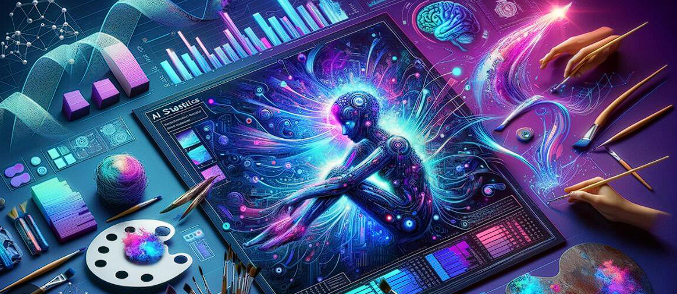But what exactly is AI? How does it work, and why does it matter so much today? In this blog, we’ll explore the world of AI—its history, how it’s transforming our world, the benefits it offers, the challenges it presents, and what the future might look like.

What Is Artificial Intelligence?
Artificial Intelligence refers to the development of computer systems that can perform tasks normally requiring human intelligence. These tasks include things like learning, reasoning, problem-solving, understanding language, and recognizing images or sounds.
AI can be divided into two broad types:
- Narrow AI – Designed to perform a specific task (e.g., facial recognition, language translation).
- General AI – Hypothetical AI that can understand, learn, and apply intelligence like a human across a wide range of activities.
Today’s AI is primarily narrow, but it’s incredibly powerful and improving fast.
A Brief History of AI
The idea of machines thinking like humans isn’t new. As far back as ancient Greece, philosophers speculated about intelligent automata. But the formal field of AI began in the 1950s. British mathematician Alan Turing asked, “Can machines think?” His famous Turing Test set the stage for future developments.
In 1956, the term “Artificial Intelligence” was officially coined by John McCarthy at a workshop at Dartmouth College. Early AI focused on logic and problem-solving but faced limitations due to weak computing power and lack of data.
The AI field experienced several ups and downs—known as “AI winters”—but saw a major resurgence in the 2010s thanks to advances in machine learning, big data, and computing power.
How Does AI Work?
At its core, AI relies on data. The more data it has, the better it can learn. Here are some key technologies behind AI:
- Machine Learning (ML): Computers learn from data without being explicitly programmed. For example, an ML model can learn to identify spam emails by analyzing thousands of examples.
- Deep Learning: A subset of ML inspired by how the human brain works. It uses neural networks with multiple layers to process complex data like images, sound, and language.
- Natural Language Processing (NLP): Helps machines understand and respond to human language. This powers chatbots, translation tools, and voice assistants.
- Computer Vision: Enables machines to interpret and process visual information from the world.
AI in Everyday Life
AI is not just a futuristic concept. It’s already deeply integrated into our daily lives:
- Smartphones: Face unlock, autocorrect, and voice assistants.
- Streaming Services: Personalized recommendations on Netflix, YouTube, and Spotify.
- Social Media: Content suggestions, spam detection, and facial recognition.
- E-commerce: Product suggestions, dynamic pricing, and customer support bots.
- Healthcare: Disease detection, virtual health assistants, and drug discovery.
- Finance: Fraud detection, robo-advisors, and automated trading.
Even if you don’t realize it, you probably interact with AI multiple times a day.
AI in Industry and Business
Businesses are using AI to gain a competitive edge:
- Retail: AI analyzes customer behavior to optimize inventory and personalize experiences.
- Manufacturing: Robotics and predictive maintenance reduce downtime and improve efficiency.
- Logistics: AI-powered routing tools save fuel and deliver faster results.
- Banking: AI helps assess credit risk, detect fraud, and provide smart customer service.
- Marketing: Companies use AI to analyze trends, target ads, and automate customer outreach.
In almost every sector, AI is improving productivity, reducing costs, and opening new possibilities.
Benefits of AI
AI brings many benefits to individuals, organizations, and society as a whole:
- Efficiency and Speed: AI can analyze vast amounts of data in seconds, helping us make faster decisions.
- Automation: Repetitive tasks can be automated, freeing up humans for more meaningful work.
- Precision: In fields like healthcare and engineering, AI can enhance accuracy and reduce human error.
- Accessibility: Tools like real-time translation and voice typing make technology more inclusive.
- Personalization: AI tailors experiences to individual users, from news feeds to shopping.
Challenges and Concerns
Despite its benefits, AI also comes with significant challenges:
- Job Displacement: Automation could replace many jobs, especially in routine or manual labor sectors. While new jobs may be created, reskilling workers is a major challenge.
- Bias and Fairness: AI systems can reflect and even amplify biases present in the data they’re trained on, leading to unfair outcomes in hiring, policing, or lending.
- Privacy: AI systems often rely on personal data, raising concerns about how that data is used and protected.
- Transparency: Many AI models are “black boxes,” meaning we don’t always understand how they make decisions.
- Security and Abuse: AI can be used maliciously—for surveillance, spreading misinformation, or creating deepfakes.
These issues call for responsible development and governance of AI technologies.
The Future of AI
AI will continue to grow, and its future holds incredible promise:
- Healthcare Revolution: AI will help detect diseases earlier, develop personalized treatments, and possibly even extend human life.
- Education: Adaptive learning platforms will provide customized education for every student.
- Sustainable Development: AI can help monitor climate change, optimize energy usage, and support conservation efforts.
- General AI: Though still far off, the goal of building machines with human-level intelligence continues to inspire research.
But the future of AI isn’t just about what machines can do—it’s also about how we choose to use them. Will AI serve everyone equally? Will it be used to empower or control? The answers lie in the choices we make today.
Conclusion
Artificial Intelligence is not just a technological innovation; it’s a transformative force that is reshaping the world. From smart assistants in your phone to complex algorithms managing global logistics, AI has already proven its power and potential.
But with great power comes great responsibility. To ensure AI benefits everyone, we must invest in ethical design, inclusive policies, and human-centered innovation.
As we move forward, AI will increasingly be a partner in our progress—not just a tool we use, but a collaborator in building a better, smarter, and more equitable future.

